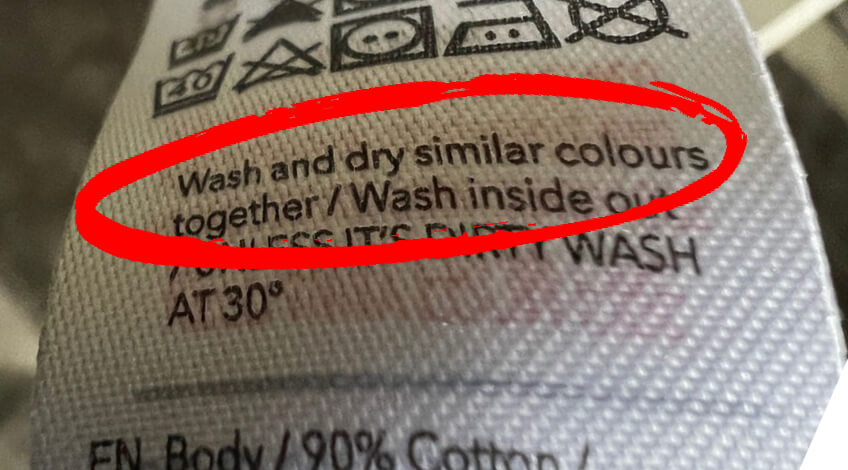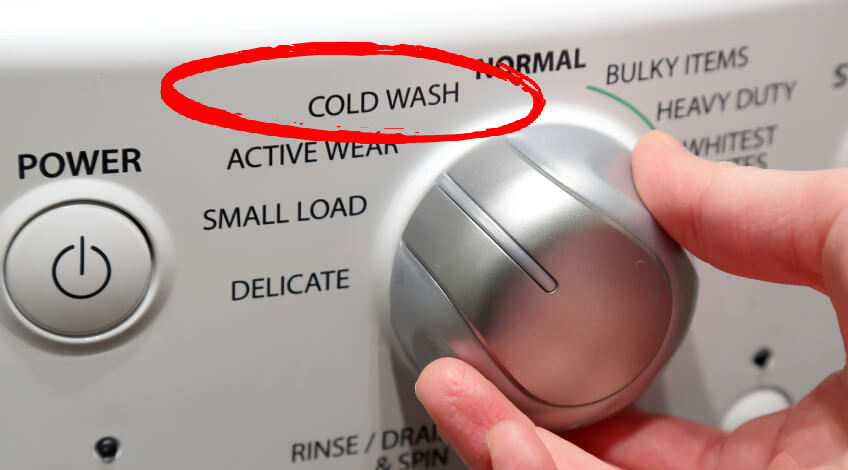
What Does “Wash With Like Colours” Mean On Clothes?
When you’re doing your laundry and you come across that little tag on your clothes that says “wash with like colours,” you might be wondering what it really means.
If the garments have “wash with like colours” in their care label tag it means that you should wash garments that are similar in colours together.
But what does it really mean, and why should you pay attention to it? In this article, we’re going to break it down for you. Let’s start!
What “Wash With Like Colours” Means On Your Clothing
First things first, those tags on your clothes aren’t just for show. They’re care labels, and they contain important information on how to care for your garment. This includes instructions on washing, drying, and even getting those pesky creases out.
Now, when you spot the phrase “wash with similar colours” on your clothing’s care label, it’s not just a casual suggestion. This instruction is there for a reason. It’s telling you that the garment should be washed and dried with clothes that are either identical in colour or at least very similar shades.

Why, you ask? Well, it all comes down to the potential for colour bleed. Some fabrics are more prone to releasing their dye during a wash, and this can spell trouble for your wardrobe. Washing similar colours together is like giving your clothes a safety net against colour mishaps.
Tip: Protect Garments with Colour Catchers
Want to go the extra mile in protecting your clothing? Consider using colour catchers! These nifty sheets can be tossed into your laundry load, and they’ll absorb any excess dye that might escape from your garments. You can find them easily online or in your local store.
- Colour Catcher – The No.1 laundry sheet for colour protection in the UK & ROI*
- Protection - The sheet acts as a magnet to trap loose dye, assuring maximum protection against discolouration and colour runs
Does Washing Similar Colours Together Prevent Colour Transfer?
Here’s the thing – washing similar colours together doesn’t guarantee that colour transfer won’t happen.
However, when it does occur, it’s less likely to be a noticeable disaster. This is because if the dye does bleed, it won’t change the fabrics colour as much as it would if the item was a totally different colour.
So, while it won’t completely eliminate the risk, it certainly reduces the potential damage.
But here’s a handy tip: if you’ve got brand-new clothes that advise you to wash them with similar colours, it’s a good idea to wash them separately for the first few rounds. New clothes tend to release more dye, which can be bad for your laundry.
Tip: Play It Safe with New Clothes
To be on the safe side, give your new garments a solo wash or include them in a load of similar colours. This will prevent any unwanted dye disasters that could ruin your other clothes.
What About Striped Or Multi-Coloured Clothes?
Now, you might be thinking, “What do I do with striped or multi-coloured clothes?”
For striped or multi-coloured garments, you’ll need to observe your garment. Take a good look at your clothing and figure out which colour dominates. If you have a red shirt with green stripes, it’s safest to toss it in with your dark-coloured clothes due to that dominant red. However, if the garment is predominantly light in colour, it can mingle with your lighter laundry.
Still unsure? Try a simple test. Soak the item in a basin of water for a few hours. If the water changes colour significantly, it’s a sign that the dye might bleed. In that case, wash it separately until the dye remains stable and doesn’t leach out.
Tip: Do Cold Washes
Here’s a golden rule to remember: hot washes are usually not great for your coloured clothes as it encourages colour bleed and makes your clothes fade faster. Stick to colder wash temperatures, around 30 degrees Celsius, to keep those vibrant colours intact.
Other Ways To Prevent Colour Transfer
We’ve all been there – you wash your white shirt, and it comes out looking suspiciously pink. Avoiding this situation is entirely possible with the following tips:
Turn Clothes Inside Out
One simple technique to reduce the risk of colour transfer is turning your clothes inside out before washing. This helps keep any excess dye on the inside of your garments, preserving the outer layer’s appearance.
SEE ALSO: Is It Better To Wash Clothes Inside Out? (yes! here’s why)
Use Cold Water
As mentioned before, cold water is your friend when it comes to preventing dye disasters.
Not only does it save energy, but it also keeps those dyes from bleeding onto your other garments. So, switch to colder wash settings, and both your clothes and the environment will thank you.

Deal With Stains Immediately
Accidents happen, and stains are just a part of life. If you spot any colour transfer while doing laundry, don’t panic. Act swiftly!
Treat the affected area with a stain remover or a mixture of water and mild detergent before re-washing the item.
Make Laundry Easy While Keeping Your Clothes Vibrant
Simply put, “wash with like colours” is a straightforward instruction that helps you protect your clothes from potential dye disasters.
By following this advice and incorporating a few extra tips, you can keep your wardrobe looking fresh and colourful without any unwanted surprises in the laundry room!
Do you have any questions? Feel free to leave a comment below!
Frequently Asked Questions
If you don’t wash clothes with like colours, different coloured fabrics might bleed onto each other, causing colour transfer and potentially staining your clothes.
Yes, washing like colours on a cold water setting, typically around 30 degrees Celsius, is a good way to prevent colour bleed and preserve the vibrancy of your clothes.
It’s generally better to sort your laundry and wash similar coloured clothes together to prevent colour transfer and potential damage.
You can wash black clothes with dark colours, but it’s best to avoid washing them with light or white fabrics to prevent potential colour bleeding onto lighter items.
Colours are more likely to bleed in warm water, so it’s advisable to use cold water for washing coloured clothing to minimise the risk of colour transfer.





